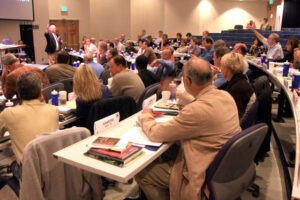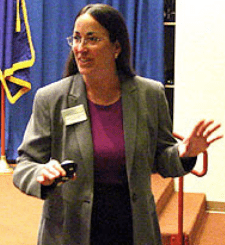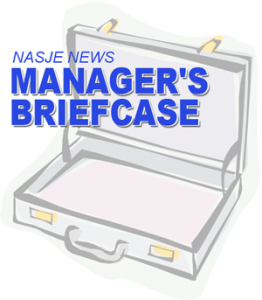Dr. Deborah Williamson, Adam K. Matz, Jim Columbia, Janet Bixler & NormaJean Conn
Introduction
The Kentucky Court of Justice (KCOJ) processes over a million cases per year. Though caseloads continue to rise throughout the state the KCOJ has reluctantly relinquished over 100 full-time positions as a result of economic woes incurred over the past two years (Hiatt, 2009; 2010). Now more than ever the courts must operate more efficiently to maximize resources, provide justice, resolve civil disputes, assist victims of crime, and protect the employees who depend on the KCOJ. One method that has consistently aided organizations in efficiency is the proper investment in technological solutions that reduce tedious tasks through automation, thereby freeing up valuable worker time and effort for more complex tasks. However, there appears to be some anecdotal accounts of the KCOJ’s primary case management system, KYCourts II, as being outdated, possessing an unintuitive interface that contributes to errors in data entry, lacking of documentation and training on how the system is organized and/or how to use it, and lacking standardization across circuits and districts (Matz, Adams, & Williamson, 2010; Matz, Adams, Williamson, Cloyd, & Schiflett, 2009). Further complicating matters is the reality that KYCourts II is but one of several case management systems in use by the Kentucky Court of Justice. These systems, though invaluable to the courts, have often been criticized for being uncoordinated and requiring monotonous duplication.
An assessment conducted by the National Center for the State Courts (NCSC) reiterated many of these points and also made note of the need for the Administrative Office of the Courts (AOC) Technology Department to more actively engage feedback from the field when developing case management solutions for the courts (Clark & Embley, 2009). Following the recommendations of the NCSC and the new CIO Charles Byers, the AOC has since convened a working group of business analysts to actively seek out feedback from the field. They have been tasked with determining the needs of practitioners who work in the field everyday (e.g., judges, clerks, pretrial officers, court designated workers, etc.). In addition to numerous interviews, focus groups and telephone conversations, a web-based survey was developed to solicit additional input from all KCOJ employees. Best regarded as a pilot project, preliminary results of the survey are discussed herein with implications for system needs and recommendations for further research.
Survey Instrument And Dissemination
To gather more input from the field a web-based survey instrument was developed using available literature on technology solutions and the working expertise of the business analysts, research experts, and the director’s office. The team relied heavily on technology assessments and literature available from the Tennessee, North Dakota, Oklahoma, and Maryland court systems (see Crawford, Koenig, Polansky, Smith, & Lyons, 1999; MTG Management Consultants, L.L.C., 2009; National Task Force on Court Automation and Integration, 2001). Time constraints prohibited a more thorough survey methodology (see Babbie, 2007; Fitzgerald & Cox, 1992; Leeuw, Hox, & Dillman, 2008). The business analysts convened for the first time to discuss the survey on October 22, 2010. After carefully reviewing available literature an initial draft instrument was developed on November 7th and shared with members of the business analyst working-group as well as Dr. Williamson and Kathy Schiflett for their research expertise. Numerous suggestions and revisions were incorporated into a near-final version before being remitted to the director’s office on November 15th. Dr. Williamson and the working group worked with the director’s office in making several additional revisions to make the survey suitable for all KCOJ personnel. The survey was constructed and facilitated using a web-based application known as SelectSurvey. A pre-notice e-mail was sent to all KCOJ staff on December 2nd, which detailed the purpose of the survey and why it was important for respondents to complete the questionnaire. It also provided the date as to when associates should expect to receive the survey. The survey was officially rolled-out on December 8th by e-mail. An accompanying e-mail message reiterated the survey’s importance and provided a link to the web-based questionnaire. The survey was set up as anonymous (did not require a logon/registration) but was limited to one response per computer/ IP address. A follow-up e-mail was sent out to all KCOJ staff on December 14th before the survey was closed on December 15th.
Of the 4,111 e-mail inboxes reported to have received the survey notice, there were a total of 1,066 total respondents (though SelectSurvey indicated 1,120 had opened the survey, 54 did not actually complete any items of the survey). As of December 6th it was indicated there were 3,584 KCOJ employees and 403 elected officials (e.g., elected justices, judges, and circuit court clerks). This gives us a total of 3,987 KCOJ employees. It was indicated that the survey e-mail reached a total of 4,111 recipients. It is unclear the source of the discrepancy (e.g., one source could be e-mail accounts that have remained active after employees have resigned or left the KCOJ). Though mostly an approximation, we can say that of the 4,111 e-mail inboxes, which received a link to the survey, there was a response rate of 25.9%.
Findings
Respondent Characteristics
Respondents vary across all levels of the KCOJ with most consisting of AOC employees (34.3%). However, there is a good variety of respondents from circuit court (14.7%), family court (8.8%), district court (16.5%), and the office of the circuit court clerk (19.0%). This suggests, to some extent, adequate representation across the various specialties of the KCOJ. The majority of respondents were female (54.6%) and white (64.2%). These results do coincide with the general demographics of the KCOJ. Not looking at the roughly 400 elected officials (of which demographic data were not readily available), of the approximately 3,575 KCOJ employees 2,780 (77.8%) were female and 795 (22.2%) were male as reported by the AOC’s Human Resources Department. In addition 3,318 (92.8%) were reported as being white and 257 non-white (7.2%). These comparisons lend support to the generalization of these findings to the KCOJ abroad.
Of the 737 responses to the experience item, on average respondents had worked at the KCOJ for about 10 years. The standard deviation was 7.4 meaning on average respondents’ experience varied from the mean about 7 and a half years. The range was 0 to 41 years. Finally, the average (i.e., mean) age of the 690 respondents who answered the birth-year item was 44.1 with a standard deviation of 11.9. In other words, on average respondents were 44 years of age and, on average, respondents’ age varied from the mean about 12 years. Age ranged from a low of 18 to a high of 80 years old.
Technology in the Courts
Though we may be in the ‘digital age’ results indicate the courts are still in transition. Over 75% of respondents indicate still using paper documents or a combination of paper and electronic documents. Only 2% of respondents indicated they have liberated themselves from paper files completely.
Though most respondents indicated they rely on KYCourts II (31.2%) as their primary case management system, there are well over a dozen individual data systems in use within the courts. Each system corresponds to a unique purpose and is maintained independently from the others.
When asked of their confidence in data provided by their system, or the KCOJ overall, most respondents were confident or very confident (61.2% and 58.4% respectively) the data were accurate and reliable. This is encouraging and, in some ways, surprising given the many anecdotal comments from the field about the systems and the various errors that lurk within them. Only about 6% of respondents indicated a lack of confidence in the courts data. However, it’s possible those employees who are most disgruntled with the systems data may have declined participation in the survey. In addition, it’s likely that respondents answered these items in relation to their belief in their own data quality and not necessarily the system holistically.
Instead of improving data quality, what appears to be the motivating force behind many KCOJ employees’ desire for a new case management system is the prospect of better coordination and integration between courts and departments. Over 60% of all respondents indicated the integration of electronic data from all four levels of the court system into one case management system was important (25.6%) or very important (40.7%). There’s a clear desire for more intra-agency information sharing and collaboration.
The KCOJ has a somewhat mixed reputation for being on the cutting-edge of technology. Though roughly 35% of employees feel the KCOJ is technologically savvy, about 31% of employees were neutral and 14% felt the KCOJ has failed to keep up with modern technological advancements. Over 60% of respondents indicated they could do their job better if they had the right technological tools. Likewise, the KCOJ would benefit from improved efficiency.
When asked about developing case management solutions employees indicated a strong desire to borrow or learn from tools used successfully by other state courts (62.0%). When asked about the use of vendors to supply case management solutions the field was generally indifferent showing no preference or disdain towards their procurement (30.8% agreed, 32.7% were neutral, and 16.9% disagreed with the use of vendors).
Desirable Features
There’s a strong interest in web-based applications and services through the case management system (58.3%). Such service allows for greater accessibility and flexibility. When asked about specific services to aid in data entry and case management the majority of respondents were in favor of all suggested solutions. Items concerned features including warning prompts (68.8%), default codes (58.4%), calendar integration (61.3%), instant messaging (57.1%), access to multimedia (e.g., audio, video) files (58.2%), pop-up reminders or ‘ticklers’ (62.3%), warrant generation (52.4%), keyword/individual searches of the system (61.9%), and access of court information from a variety of mobile devices including Kindles and smart phones (47.2%).
Recommendations
Practical Implications
There is a keen desire for more integration of KCOJ systems across jurisdictions and court levels. Further, there is a clear indication the full potential of current personnel has not yet been realized due to case management system inadequacies.
Support for a case management solution that integrates the various courts; provides improved accessibility and flexibility; and better meets the needs of judges, clerks, and the many other court professionals has steadily risen over the past couple of years. The case management system exists at the heart of the court system. Without a fully functional system the courts will struggle to manage rising caseloads, subjecting itself to potential delays in justice and a reduction in public safety abroad. In some respects the need for a more integrated case management system is a reflection of the growing pains of a unified judicial system that continues to manifest itself through various forms and associations (see Metzmeier, Whiteman, & Nemes, 2006).
The question is not if the KCOJ needs a modern technology solution but rather what this system should do, how to develop it, and what costs are likely to be incurred. Unfortunately, such questions are beyond the scope of this article.
Implications for Further Research
This article contains a brief overview of quantitative data compiled from the KCOJ Case and Docket Management System Survey. That said further research is sorely needed. Each court, department, and position level possesses unique needs that require a distinct survey tailored for each. In addition, the courts and its data do not exist in a vacuum but rather in coordination with numerous external agencies. Changes in case management technology require the input of outside constituents and partners including the Department of Public Advocacy, Department of Corrections, and law enforcement.
The courts are strongly urged to use a variety of research strategies. Prior to survey development business analyst should first develop an intimate body of knowledge of a given court or department through designated focus groups and interviews with relevant personnel. In addition, a more thorough literature search and review is needed. Combined, these materials provide the necessary backdrop for more thorough survey conceptualization and operationalization. This, however, is only the beginning of survey development. Each survey, tailored to a given court/department, must then be pre-tested with professionals in that court/department to ensure its applicability and clarity. Once an instrument is fully developed it should be disseminated by mail as a paper document (results of this survey showed many court professionals still prefer paper documents). The process should start with a pre-notice letter, dissemination of the survey a week later, a follow-up survey two weeks later, a second follow-up with an additional copy of the survey two more weeks later, and a final reminder letter in another two weeks (see Leeuw et al., 2008). Whereas the current survey was generic to accommodate the wide variety of respondents, future surveys should be more focused. Sampling frames need to be developed and, when necessary, random stratified sampling procedures utilized if surveying entire populations would otherwise prove too extraneous or costly (see Babbie, 2007). Such technological assessments are time-consuming, but necessary. Court leaders should expect to spend 1-2 years gathering additional input and mapping out current court processes.
Note: The previous article was derived from a research brief for the KCOJ/AOC. The complete research brief contains all survey items and quantitative data tables. Please contact Jim Columbia at jimcolumbia@kycourts.net for a copy of the brief or for further correspondence.
References
Babbie, E. (2007). The practice of social research (11th ed.). Belmont, CA: Thomson Wadsworth.
Clark, T. M., & Embley, P. (2009). Kentucky courts technology assessment report. Denver, CO: National Center for State Courts.
Crawford, C., Koenig, S., Polansky, L., Smith, P., & Lyons, D. (1999). Information technology systems integration and migration analysis. Eureka, CA: Justice Served.
Fitzgerald, J. D., & Cox, S. M. (1992). Research methods in criminal justice: An introduction. Chicago: Nelson-Hall.
Hiatt, L. A. (2009, September 15). Administrative Office of the Courts announces operational cuts, abolishes 47 positions to prepare for judicial branch budget deficit. Retrieved March 28, 2010, from Kentucky Court of Justice: http://courts.ky.gov/pressreleases/095152009LAH1.htm
Hiatt, L. A. (2010, April 30). Chief Justice Minton announces Judicial Branch Reduction Plan for FY11. Retrieved May 9, 2010, from Kentucky Court of Justice: http://migration.kentucky.gov/newsroom/kycourts/PR04302010LAHA.htm
Leeuw, E. D., Hox, J. J., & Dillman, D. A. (2008). International handbook of survey methodology. New York: Lawrence Erlbaum Associates, Taylor & Francis Group.
Matz, A. K., Adams, J. H., & Williamson, D. (2010). Judicial perceptions of efficiency and culture: A research brief and needs assessment. Frankfort, KY: Kentucky Court of Justice, Administrative Office of the Courts.
Matz, A. K., Adams, J. H., Williamson, D., Cloyd, J., & Schiflett, K. (2009). Examining culture in the courtroom: A study of culture within the Kentucky Court of Justice. Frankfort, KY: Kentucky Court of Justice, Administrative Office of the Courts.
Metzmeier, K. X., Whiteman, M., & Nemes, J. (2006). United at last: The judicial article and the struggle to reform Kentucky’s courts. Frankfort, KY: Kentucky Court of Justice, Administrative Office of the Courts.
MTG Management Consultants, L.L.C. (2009). Maryland Administrative Office of the Courts case management system replacement: Integrated statewide case management system project charter. Seattle, WA.
National Task Force on Court Automation and Integration (2001). Court technology survey report. Sacramento, CA: SEARCH, The National Consortium for Justice Information and Statistics.
Biographies
 Dr. Deborah Williamson is a veteran manager with the Kentucky Administrative Office of the Courts, Dr. Deborah Williamson currently serves as the Executive Officer of the Department of Court Services. Spanning over two decades, Williamson’s career with the state court system has involved diverse assignments such as management of the statewide juvenile intake program, grants office, and the nationally renowned judicial branch education program. A Doctor of Philosophy graduate from the University of Kentucky, Dr. Williamson is currently developing courses in the subfield of criminology for undergraduates majoring in sociology. Her publications have appeared in Crime and Delinquency, Journal of Social Work in Education, and Juvenile and Family Court Journal.
Dr. Deborah Williamson is a veteran manager with the Kentucky Administrative Office of the Courts, Dr. Deborah Williamson currently serves as the Executive Officer of the Department of Court Services. Spanning over two decades, Williamson’s career with the state court system has involved diverse assignments such as management of the statewide juvenile intake program, grants office, and the nationally renowned judicial branch education program. A Doctor of Philosophy graduate from the University of Kentucky, Dr. Williamson is currently developing courses in the subfield of criminology for undergraduates majoring in sociology. Her publications have appeared in Crime and Delinquency, Journal of Social Work in Education, and Juvenile and Family Court Journal.
 Adam K. Matz, M.S. is a Research Associate with the American Probation and Parole Association (APPA) and former Statistician for the Kentucky Administrative Office of the Courts. His research has focused on topics of gang violence, cultural congruence in local circuit courts, social efficacy in local communities, as well as job satisfaction and organizational climate within juvenile justice institutions. Additionally, he now serves as consultant and Business Analyst for the Kentucky Court of Justice data system improvement project. Mr. Matz earned his bachelor’s degree in police studies and master’s degree in correctional and juvenile justice studies from Eastern Kentucky University. His publications have appeared in journals such as Criminal Justice and Behavior and Criminal Justice Review.
Adam K. Matz, M.S. is a Research Associate with the American Probation and Parole Association (APPA) and former Statistician for the Kentucky Administrative Office of the Courts. His research has focused on topics of gang violence, cultural congruence in local circuit courts, social efficacy in local communities, as well as job satisfaction and organizational climate within juvenile justice institutions. Additionally, he now serves as consultant and Business Analyst for the Kentucky Court of Justice data system improvement project. Mr. Matz earned his bachelor’s degree in police studies and master’s degree in correctional and juvenile justice studies from Eastern Kentucky University. His publications have appeared in journals such as Criminal Justice and Behavior and Criminal Justice Review.
 James R. Columbia retired from the Kentucky Administrative Office of the Courts in 2009 after a 22-year career that included positions as a Court Designated Worker, Regional Supervisor and Information Systems Supervisor for the Juvenile Services division, in which capacity he coordinated development of a statewide, electronic case management and data system. He subsequently was appointed Manager of the Records and Research & Statistics divisions of the AOC. He now serves as consultant and Business Analyst for the Kentucky Court of Justice data system improvement project. Mr. Columbia holds an associate degree in science from Maysville Community College and a bachelor’s degree in business, with a major in accounting, from the University of Kentucky.
James R. Columbia retired from the Kentucky Administrative Office of the Courts in 2009 after a 22-year career that included positions as a Court Designated Worker, Regional Supervisor and Information Systems Supervisor for the Juvenile Services division, in which capacity he coordinated development of a statewide, electronic case management and data system. He subsequently was appointed Manager of the Records and Research & Statistics divisions of the AOC. He now serves as consultant and Business Analyst for the Kentucky Court of Justice data system improvement project. Mr. Columbia holds an associate degree in science from Maysville Community College and a bachelor’s degree in business, with a major in accounting, from the University of Kentucky.
 Janet Bixler has joined the Administrative Office of the Courts as a Business Analyst for researching the needs for a unified case management system. She has served as a business analyst, technical writer, and project manager in the technology industry. Ms Bixler has expertise in researching current information technology processes, developing new processes, and documenting and training those processes to applicable users. Ms. Bixler earned her bachelor’s degree in journalism with a minor in political science from the University of Kentucky. She has completed information technology classes at the Kentucky Community & Technical College System.
Janet Bixler has joined the Administrative Office of the Courts as a Business Analyst for researching the needs for a unified case management system. She has served as a business analyst, technical writer, and project manager in the technology industry. Ms Bixler has expertise in researching current information technology processes, developing new processes, and documenting and training those processes to applicable users. Ms. Bixler earned her bachelor’s degree in journalism with a minor in political science from the University of Kentucky. She has completed information technology classes at the Kentucky Community & Technical College System.
 Jean Conn serves as a Business Analyst for the Administrative Office of the Courts. She will work with a newly appointed project team to research and document the business needs for a new case management system. Mrs. Conn was a Project Manager and Business Analyst for Humana, Automatic Data Processing, Kindred Healthcare and Brown & Williamson Tobacco. She has extensive experience working as a liaison between Information Technology and the business users. Mrs. Conn has implemented a variety of systems such as HRIS, benefits enrollment, medical insurance, and clinical systems. She graduated from Sullivan Junior College majoring in computer programming. She also attended Sullivan University and Bellarmine University.
Jean Conn serves as a Business Analyst for the Administrative Office of the Courts. She will work with a newly appointed project team to research and document the business needs for a new case management system. Mrs. Conn was a Project Manager and Business Analyst for Humana, Automatic Data Processing, Kindred Healthcare and Brown & Williamson Tobacco. She has extensive experience working as a liaison between Information Technology and the business users. Mrs. Conn has implemented a variety of systems such as HRIS, benefits enrollment, medical insurance, and clinical systems. She graduated from Sullivan Junior College majoring in computer programming. She also attended Sullivan University and Bellarmine University.

 Deborah Williamson, executive officer for the AOC Department of Court Services, retired Feb. 28, 2011. Deb served the Administrative Office of the Courts for two decades in a variety of capacities and most recently oversaw the Divisions of Court Interpreting Services, Judicial Branch Education, and Records and Statistics.
Deborah Williamson, executive officer for the AOC Department of Court Services, retired Feb. 28, 2011. Deb served the Administrative Office of the Courts for two decades in a variety of capacities and most recently oversaw the Divisions of Court Interpreting Services, Judicial Branch Education, and Records and Statistics. 
 Adam K. Matz, M.S. is a Research Associate with the American Probation and Parole Association (APPA) and former Statistician for the Kentucky Administrative Office of the Courts. His research has focused on topics of gang violence, cultural congruence in local circuit courts, social efficacy in local communities, as well as job satisfaction and organizational climate within juvenile justice institutions. Additionally, he now serves as consultant and Business Analyst for the Kentucky Court of Justice data system improvement project. Mr. Matz earned his bachelor’s degree in police studies and master’s degree in correctional and juvenile justice studies from Eastern Kentucky University. His publications have appeared in journals such as Criminal Justice and Behavior and Criminal Justice Review.
Adam K. Matz, M.S. is a Research Associate with the American Probation and Parole Association (APPA) and former Statistician for the Kentucky Administrative Office of the Courts. His research has focused on topics of gang violence, cultural congruence in local circuit courts, social efficacy in local communities, as well as job satisfaction and organizational climate within juvenile justice institutions. Additionally, he now serves as consultant and Business Analyst for the Kentucky Court of Justice data system improvement project. Mr. Matz earned his bachelor’s degree in police studies and master’s degree in correctional and juvenile justice studies from Eastern Kentucky University. His publications have appeared in journals such as Criminal Justice and Behavior and Criminal Justice Review. James R. Columbia retired from the Kentucky Administrative Office of the Courts in 2009 after a 22-year career that included positions as a Court Designated Worker, Regional Supervisor and Information Systems Supervisor for the Juvenile Services division, in which capacity he coordinated development of a statewide, electronic case management and data system. He subsequently was appointed Manager of the Records and Research & Statistics divisions of the AOC. He now serves as consultant and Business Analyst for the Kentucky Court of Justice data system improvement project. Mr. Columbia holds an associate degree in science from Maysville Community College and a bachelor’s degree in business, with a major in accounting, from the University of Kentucky.
James R. Columbia retired from the Kentucky Administrative Office of the Courts in 2009 after a 22-year career that included positions as a Court Designated Worker, Regional Supervisor and Information Systems Supervisor for the Juvenile Services division, in which capacity he coordinated development of a statewide, electronic case management and data system. He subsequently was appointed Manager of the Records and Research & Statistics divisions of the AOC. He now serves as consultant and Business Analyst for the Kentucky Court of Justice data system improvement project. Mr. Columbia holds an associate degree in science from Maysville Community College and a bachelor’s degree in business, with a major in accounting, from the University of Kentucky. Janet Bixler has joined the Administrative Office of the Courts as a Business Analyst for researching the needs for a unified case management system. She has served as a business analyst, technical writer, and project manager in the technology industry. Ms Bixler has expertise in researching current information technology processes, developing new processes, and documenting and training those processes to applicable users. Ms. Bixler earned her bachelor’s degree in journalism with a minor in political science from the University of Kentucky. She has completed information technology classes at the Kentucky Community & Technical College System.
Janet Bixler has joined the Administrative Office of the Courts as a Business Analyst for researching the needs for a unified case management system. She has served as a business analyst, technical writer, and project manager in the technology industry. Ms Bixler has expertise in researching current information technology processes, developing new processes, and documenting and training those processes to applicable users. Ms. Bixler earned her bachelor’s degree in journalism with a minor in political science from the University of Kentucky. She has completed information technology classes at the Kentucky Community & Technical College System. Jean Conn serves as a Business Analyst for the Administrative Office of the Courts. She will work with a newly appointed project team to research and document the business needs for a new case management system. Mrs. Conn was a Project Manager and Business Analyst for Humana, Automatic Data Processing, Kindred Healthcare and Brown & Williamson Tobacco. She has extensive experience working as a liaison between Information Technology and the business users. Mrs. Conn has implemented a variety of systems such as HRIS, benefits enrollment, medical insurance, and clinical systems. She graduated from Sullivan Junior College majoring in computer programming. She also attended Sullivan University and Bellarmine University.
Jean Conn serves as a Business Analyst for the Administrative Office of the Courts. She will work with a newly appointed project team to research and document the business needs for a new case management system. Mrs. Conn was a Project Manager and Business Analyst for Humana, Automatic Data Processing, Kindred Healthcare and Brown & Williamson Tobacco. She has extensive experience working as a liaison between Information Technology and the business users. Mrs. Conn has implemented a variety of systems such as HRIS, benefits enrollment, medical insurance, and clinical systems. She graduated from Sullivan Junior College majoring in computer programming. She also attended Sullivan University and Bellarmine University. A Georgia judge recently resigned after that State’s Judicial Qualifications Commission investigated the judge’s Facebook messaging with a defendant appearing in a pending matter before him.
A Georgia judge recently resigned after that State’s Judicial Qualifications Commission investigated the judge’s Facebook messaging with a defendant appearing in a pending matter before him. Justice Crothers regularly conducts training for judges and lawyers on ethics and technology, and on judicial disqualification. He can be reached at dcrothers@ndcourts.gov
Justice Crothers regularly conducts training for judges and lawyers on ethics and technology, and on judicial disqualification. He can be reached at dcrothers@ndcourts.gov
 The Judicial Council of California – Administrative Office of the Courts is dedicated to improving the quality of justice and services to meet the diverse needs of children, youth, families, and self-represented litigants in the California courts. One of the projects created to help improve the quality of justice provided is the Juvenile Court Users’ Research and Technical Assistance Project. The starting point for this project was the Juvenile Delinquency Court Assessment 2008, completed by the Judicial Council, which identifies the experiences of court users and professionals in California.
The Judicial Council of California – Administrative Office of the Courts is dedicated to improving the quality of justice and services to meet the diverse needs of children, youth, families, and self-represented litigants in the California courts. One of the projects created to help improve the quality of justice provided is the Juvenile Court Users’ Research and Technical Assistance Project. The starting point for this project was the Juvenile Delinquency Court Assessment 2008, completed by the Judicial Council, which identifies the experiences of court users and professionals in California.
 Kelly Tait is communication consultant with nine years of experience in judicial branch education and fifteen years of experience teaching college-level communication classes. Her areas of expertise include facilitation skills, planning and delivering effective presentations, courtroom communication skills, communicating with non-legally trained court participants, diversity issues and perceptions of procedural fairness, etc.
Kelly Tait is communication consultant with nine years of experience in judicial branch education and fifteen years of experience teaching college-level communication classes. Her areas of expertise include facilitation skills, planning and delivering effective presentations, courtroom communication skills, communicating with non-legally trained court participants, diversity issues and perceptions of procedural fairness, etc. The Kentucky Court of Justice (KCOJ) has begun the planning phase for an enterprise-level project that will update the entire court management systems environment, including technology, business processes, and management processes. The goal is to create a user-friendly case and docket management system that coordinates the flow of information between levels of court and administrative departments, and will allow users direct access to the statistical and other data they need to make informed business decisions.
The Kentucky Court of Justice (KCOJ) has begun the planning phase for an enterprise-level project that will update the entire court management systems environment, including technology, business processes, and management processes. The goal is to create a user-friendly case and docket management system that coordinates the flow of information between levels of court and administrative departments, and will allow users direct access to the statistical and other data they need to make informed business decisions.
 Janet Bixler has joined the Administrative Office of the Courts as a Business Analyst for researching the needs for a unified case management system. She has served as a business analyst, technical writer, and project manager in the technology industry. Ms Bixler has expertise in researching current information technology processes, developing new processes, and documenting and training those processes to applicable users. Ms. Bixler earned her bachelor’s degree in journalism with a minor in political science from the University of Kentucky. She has completed information technology classes at the Kentucky Community & Technical College System.
Janet Bixler has joined the Administrative Office of the Courts as a Business Analyst for researching the needs for a unified case management system. She has served as a business analyst, technical writer, and project manager in the technology industry. Ms Bixler has expertise in researching current information technology processes, developing new processes, and documenting and training those processes to applicable users. Ms. Bixler earned her bachelor’s degree in journalism with a minor in political science from the University of Kentucky. She has completed information technology classes at the Kentucky Community & Technical College System. Adam K. Matz, M.S. is a Research Associate with the American Probation and Parole Association (APPA) and former Statistician for the Kentucky Administrative Office of the Courts. His research has focused on topics of gang violence, cultural congruence in local circuit courts, social efficacy in local communities, as well as job satisfaction and organizational climate within juvenile justice institutions. Additionally, he now serves as consultant and Business Analyst for the Kentucky Court of Justice data system improvement project. Mr. Matz earned his bachelor’s degree in police studies and master’s degree in correctional and juvenile justice studies from Eastern Kentucky University. His publications have appeared in journals such as Criminal Justice and Behavior and Criminal Justice Review.
Adam K. Matz, M.S. is a Research Associate with the American Probation and Parole Association (APPA) and former Statistician for the Kentucky Administrative Office of the Courts. His research has focused on topics of gang violence, cultural congruence in local circuit courts, social efficacy in local communities, as well as job satisfaction and organizational climate within juvenile justice institutions. Additionally, he now serves as consultant and Business Analyst for the Kentucky Court of Justice data system improvement project. Mr. Matz earned his bachelor’s degree in police studies and master’s degree in correctional and juvenile justice studies from Eastern Kentucky University. His publications have appeared in journals such as Criminal Justice and Behavior and Criminal Justice Review. James R. Columbia retired from the Kentucky Administrative Office of the Courts in 2009 after a 22-year career that included positions as a Court Designated Worker, Regional Supervisor and Information Systems Supervisor for the Juvenile Services division, in which capacity he coordinated development of a statewide, electronic case management and data system. He subsequently was appointed Manager of the Records and Research & Statistics divisions of the AOC. He now serves as consultant and Business Analyst for the Kentucky Court of Justice data system improvement project. Mr. Columbia holds an associate degree in science from Maysville Community College and a bachelor’s degree in business, with a major in accounting, from the University of Kentucky.
James R. Columbia retired from the Kentucky Administrative Office of the Courts in 2009 after a 22-year career that included positions as a Court Designated Worker, Regional Supervisor and Information Systems Supervisor for the Juvenile Services division, in which capacity he coordinated development of a statewide, electronic case management and data system. He subsequently was appointed Manager of the Records and Research & Statistics divisions of the AOC. He now serves as consultant and Business Analyst for the Kentucky Court of Justice data system improvement project. Mr. Columbia holds an associate degree in science from Maysville Community College and a bachelor’s degree in business, with a major in accounting, from the University of Kentucky.